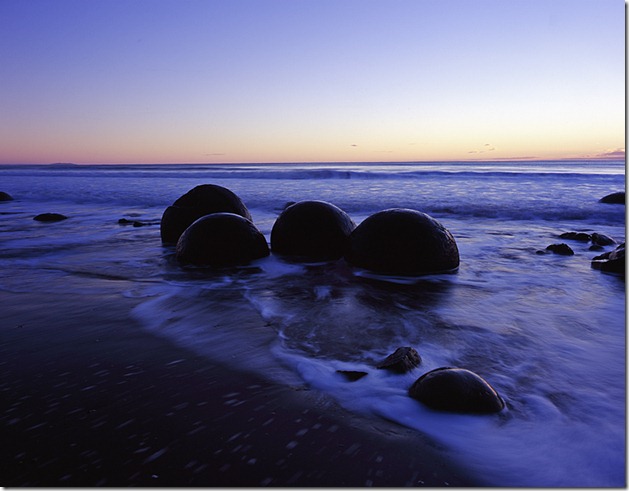Anticipation
Kualoa Beach Regional Park, Oahu, Hawaii
anticipation (ænˌtɪsɪˈpeɪʃən) — n 1. the act of anticipating; expectation, premonition, or foresight
World English Dictionary
One of the greatest pleasures that large format photography gives me is the manner in which it encourages anticipation of the end result; the photograph. This feeling of anticipation is based upon a foundation of contemplation, thought and preparation. Conceiving the photograph, setting up the camera and preparing to take the photograph is a time consuming process in large format photography; with time measured in minutes, not seconds as is common with SLR type cameras.
Anticipation is not limited to large format photographers, it’s a valuable emotion that all photographers can harness, regardless what type of camera used. It does however, require a different approach to photography than many SLR photographers are used to using. It’s an approach based upon forethought about how a scene could be rendered, and not a reaction to how it is.
Neither approach is wrong, of course, but I’ve found that my finest results come when I’ve anticipated the results before taking the photograph. So, what are the steps that go into the process of anticipation?
1. Know what you want. It seems quite elemental, but many photographers go out to take photographs without any thought given to what they desire to photograph or how it fits with their interests and photographic goals. It doesn’t matter if the objective is to photograph the sunrise, or whether the outing is part of a larger, more all encompassing, project. Knowing and defining the objective - the photographer’s “vision” - is essential.
It is not a peripheral subject reserved for the photographic elite or photographers with a sociopathic bent towards navel-gazing. It is the place we begin, and the road we travel, on the way to our goal - creating compelling photographs that express something we’ve no other means of expressing but through the frame.
David duChemin, "The Vision Driven Photographer
Without a clearly defined vision, the photographer will flounder, and there can be no real anticipation of what lies ahead, for the photograph. The lack of vision will carry over into the overall body of the photographer’s work, defining it in an unflattering manner. Vision enables you to glimpse into the future, to sense its hope and power, and builds a sense of anticipation that can be fulfilled by your photography.
2. Preparation and research. Once the determination about what to photograph has been made, the next step is to prepare to take the photograph. This can be one of the more mundane parts of the anticipation process, but it’s the part where you learn what is possible for the given subject and location.
I like to begin by considering the location and the lighting that I expect while there. Some subjects work better early in the morning, while others work better in the afternoon. Additionally, knowing the type of terrain to expect you can get a sense of how long it will take to get into position, and the direction where the majority of the lighting will come from. A good topographical map or a computer program like Photographer's Ephemeris can be quite helpful.
Dawn, Moeraki Boulders. Moeraki, New Zealand. Toyo 45AII, Schneider Symmar XL 80mm f4.5 lens on Fuji Velvia 50, .6 (two-stop) Split Neutral Density filter along the horizon.
I also make extensive use of the Internet, scouring through blogs, photographs and other sources for information about the location I’m going to photograph. As I’m going through all these, I like to keep track of the bits and pieces that I find in Microsoft OneNote, which I’ll then refer to while on location.
Not all of your research needs to be of a formal nature - after all, research is not supposed to be a chore – sometimes the research is simply based upon past experiences. It needs to be of the type that frees the mind to concentrate on the creative aspects of photography, which in turn builds excitement and anticipation.
3. Know your equipment. You need to both understand the operation of your equipment, and be able to operate it without having to pay too much attention to the physical aspects of setting it up and taking the photograph. You may need to setup and shoot in the dark, or simply work quickly in changing light.
The act of knowing the operation of your equipment means much more than knowing how to set the aperture and shutter speed. For example, it can also entail choosing the correct filters for the lighting situation; knowing how to setup and use split neutral density filters; if you are a film photographer it can entail knowing which type of film emulsion works the best in the given situation. In short, it’s about the physical aspects of taking the photograph. Knowing your equipment will often entail the need to photograph simply for the sake of keeping up proficiency with the equipment.
This is the time when the creative aspects of photography must rule. As I stated before, the creative act builds excitement and anticipation.
Finally. I hope that I haven’t given the impression that this is a long, drawn out process. In fact, anticipation can build quickly, even explosively, in a matter of seconds from the initial idea to the final photograph. Of course, that is not always the case, but when it does, these steps I’ve laid out lead to being prepared, regardless how quickly or slowly it strikes.
In his book, “The Vision Driven Photographer” photographer David duChemin recounts his series of photographs about a blind man in Nepal. His narrative clearly shows the thought processes that led up to anticipating his final results. This narrative clearly illustrates a build up of anticipation and excitement.
Photo Narration
Moonrise over Chinaman’s Hat – For this photograph, I knew that when the trade winds weren’t blowing, that there are certain areas along the windward coast of Oahu where the water would be still, the trees almost unmoving, and the sky would be fairly clear. Kualoa Beach Park is one of the places I go in these situations. What I didn’t anticipate was that the sliver of the moon would be so close to the horizon. Fortunately, I knew my equipment well enough to be able to set it up in the dark.
Dawn, Moeraki Boulders – I had arrived the afternoon before this photograph was taken. While there I scouted around the boulders to see how they lay in relation to the beach. At the time the surf was out, and the boulders were dry. I camped out at a nearby campground, and made the short 1.5km walk from the campground to the boulders in the dark. Living in Hawaii, I was quite familiar with shooting along the shoreline, so after setting up this shot, I waited until the surf had just begun to retreat before snapping the shutter. I knew this was the optimum time, when the sand would still be wet, and I could get a sense of movement in the water.
More Information
- The Vision Driven Photographer – David duChemin. An excellently written and insightful ebook detailing the process of thinking about the photograph – thinking about the photographers “Vision”.
- Landscape Within – David Ward. If there is a philosopher in photography, I would have to think that David Ward is it. David’s book “Landscape Within” gets to the heart of why we photograph the way we do, and why we look at the landscape as we do.



0 Comments on "Anticipation"